Business Environment Report: Types, Functions, Macro Analysis
VerifiedAdded on 2023/06/05
|17
|4710
|79
Report
AI Summary
This report provides a detailed analysis of the business environment, examining different types of organizations including public, private, and voluntary sectors, and their legal structures. It explores the size and scope of various organizations, such as BBC, Marks & Spencer, and Shelter England, detailing their functions and how they link to organizational objectives and structure. The report identifies the positive and negative impacts of the macro environment, including political, economic, and social factors, on business operations, using specific examples. Furthermore, it conducts an internal and external analysis of specific organizations to identify strengths and weaknesses and explains how these interrelate with external macro factors. Desklib offers this comprehensive solution along with a wide range of study resources for students.
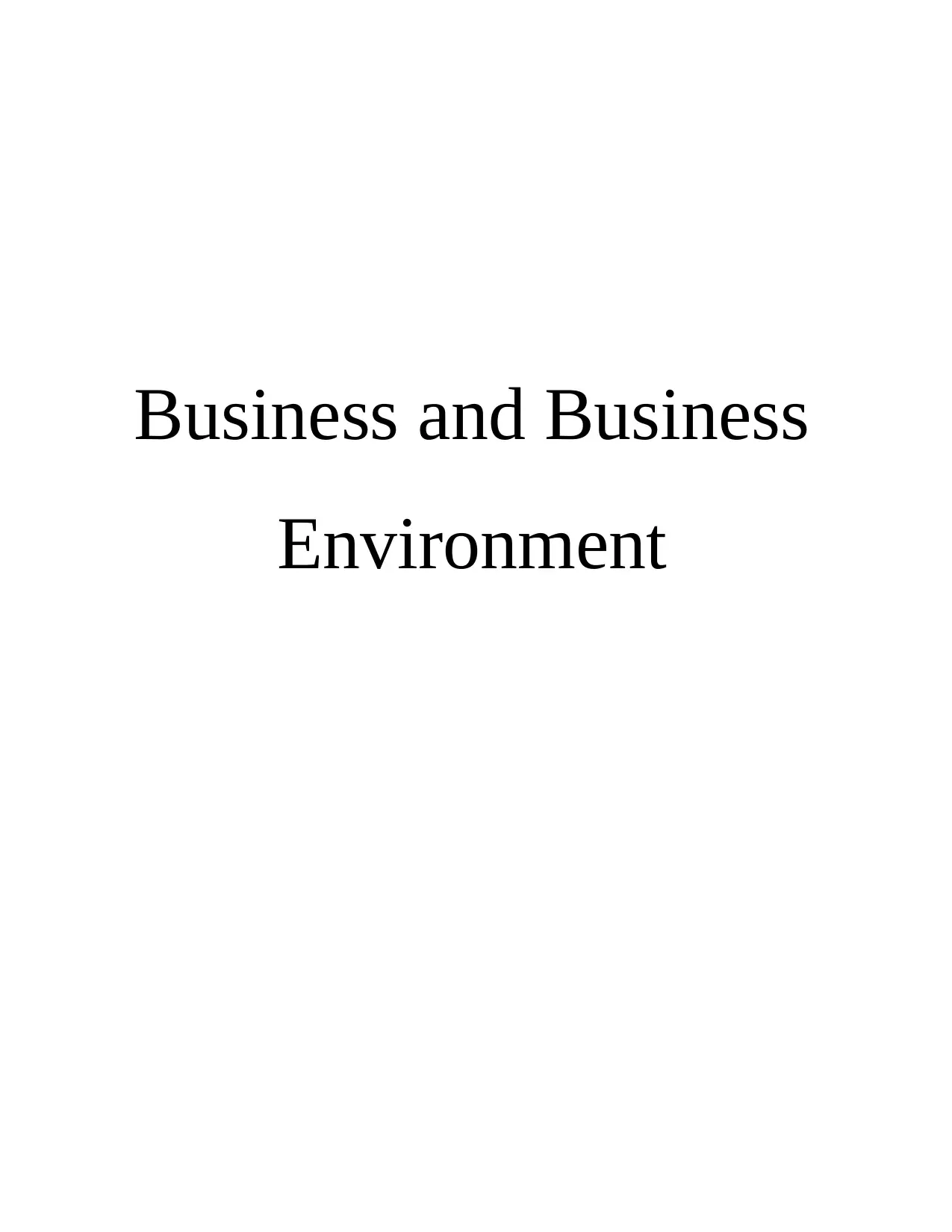
Business and Business
Environment
Environment
Paraphrase This Document
Need a fresh take? Get an instant paraphrase of this document with our AI Paraphraser
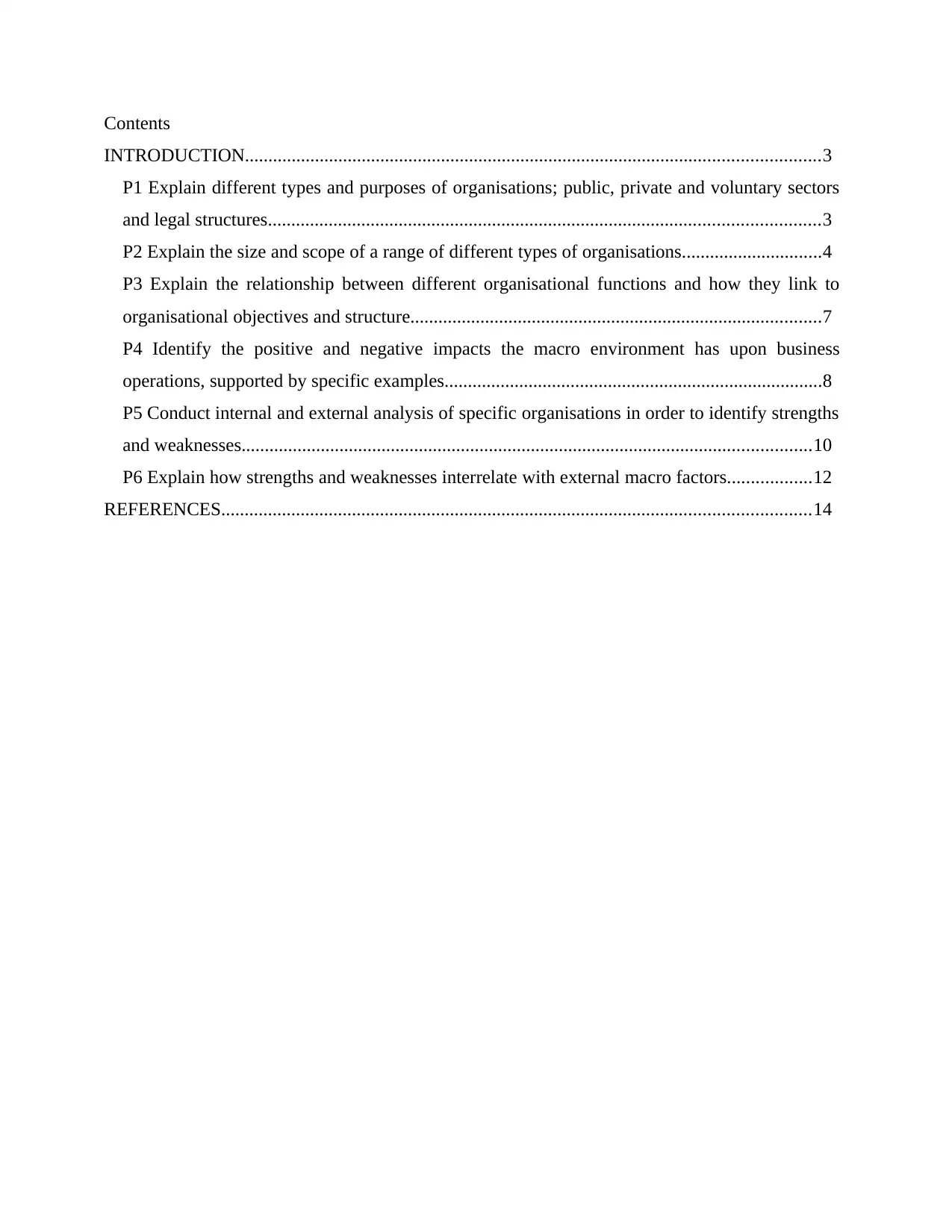
Contents
INTRODUCTION...........................................................................................................................3
P1 Explain different types and purposes of organisations; public, private and voluntary sectors
and legal structures......................................................................................................................3
P2 Explain the size and scope of a range of different types of organisations..............................4
P3 Explain the relationship between different organisational functions and how they link to
organisational objectives and structure........................................................................................7
P4 Identify the positive and negative impacts the macro environment has upon business
operations, supported by specific examples.................................................................................8
P5 Conduct internal and external analysis of specific organisations in order to identify strengths
and weaknesses..........................................................................................................................10
P6 Explain how strengths and weaknesses interrelate with external macro factors..................12
REFERENCES..............................................................................................................................14
INTRODUCTION...........................................................................................................................3
P1 Explain different types and purposes of organisations; public, private and voluntary sectors
and legal structures......................................................................................................................3
P2 Explain the size and scope of a range of different types of organisations..............................4
P3 Explain the relationship between different organisational functions and how they link to
organisational objectives and structure........................................................................................7
P4 Identify the positive and negative impacts the macro environment has upon business
operations, supported by specific examples.................................................................................8
P5 Conduct internal and external analysis of specific organisations in order to identify strengths
and weaknesses..........................................................................................................................10
P6 Explain how strengths and weaknesses interrelate with external macro factors..................12
REFERENCES..............................................................................................................................14
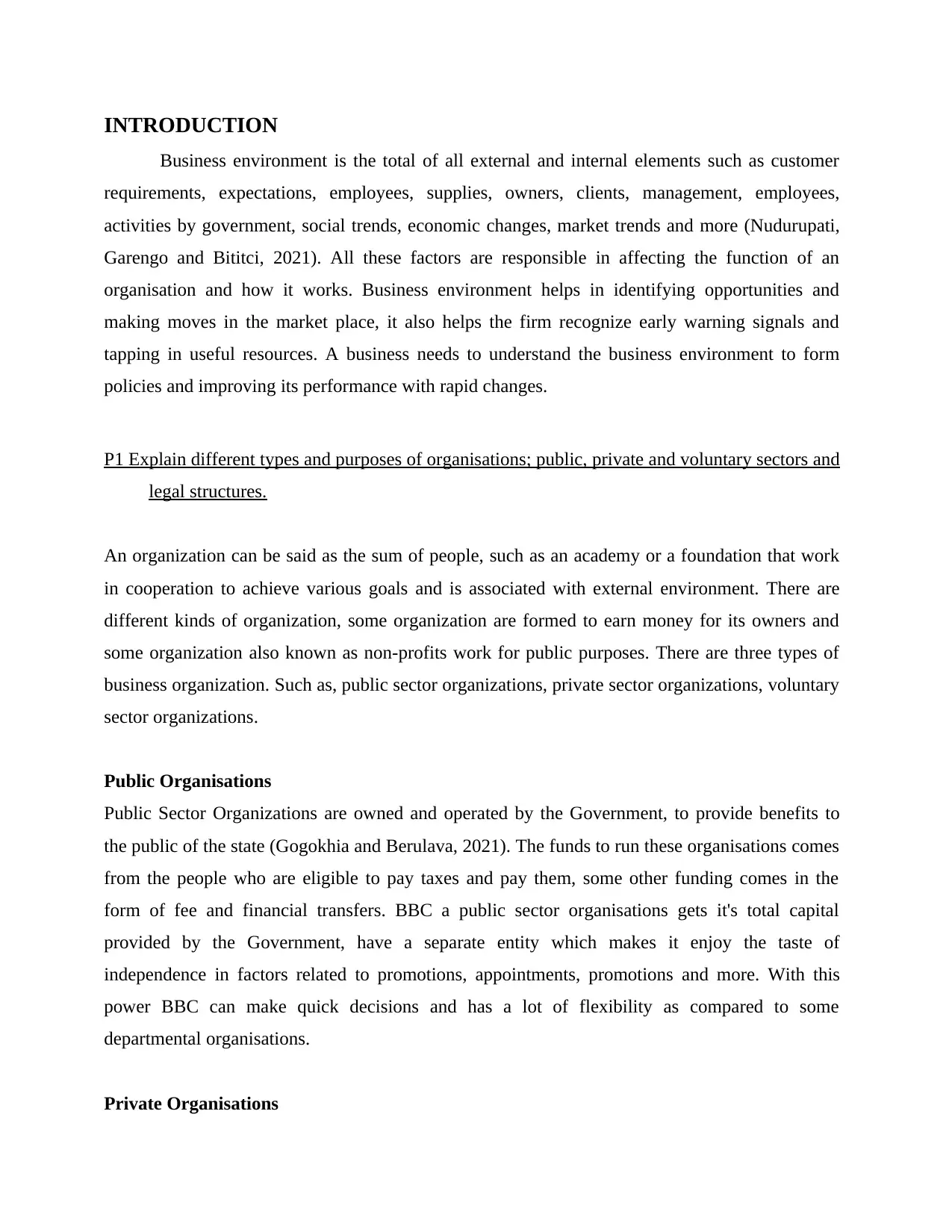
INTRODUCTION
Business environment is the total of all external and internal elements such as customer
requirements, expectations, employees, supplies, owners, clients, management, employees,
activities by government, social trends, economic changes, market trends and more (Nudurupati,
Garengo and Bititci, 2021). All these factors are responsible in affecting the function of an
organisation and how it works. Business environment helps in identifying opportunities and
making moves in the market place, it also helps the firm recognize early warning signals and
tapping in useful resources. A business needs to understand the business environment to form
policies and improving its performance with rapid changes.
P1 Explain different types and purposes of organisations; public, private and voluntary sectors and
legal structures.
An organization can be said as the sum of people, such as an academy or a foundation that work
in cooperation to achieve various goals and is associated with external environment. There are
different kinds of organization, some organization are formed to earn money for its owners and
some organization also known as non-profits work for public purposes. There are three types of
business organization. Such as, public sector organizations, private sector organizations, voluntary
sector organizations.
Public Organisations
Public Sector Organizations are owned and operated by the Government, to provide benefits to
the public of the state (Gogokhia and Berulava, 2021). The funds to run these organisations comes
from the people who are eligible to pay taxes and pay them, some other funding comes in the
form of fee and financial transfers. BBC a public sector organisations gets it's total capital
provided by the Government, have a separate entity which makes it enjoy the taste of
independence in factors related to promotions, appointments, promotions and more. With this
power BBC can make quick decisions and has a lot of flexibility as compared to some
departmental organisations.
Private Organisations
Business environment is the total of all external and internal elements such as customer
requirements, expectations, employees, supplies, owners, clients, management, employees,
activities by government, social trends, economic changes, market trends and more (Nudurupati,
Garengo and Bititci, 2021). All these factors are responsible in affecting the function of an
organisation and how it works. Business environment helps in identifying opportunities and
making moves in the market place, it also helps the firm recognize early warning signals and
tapping in useful resources. A business needs to understand the business environment to form
policies and improving its performance with rapid changes.
P1 Explain different types and purposes of organisations; public, private and voluntary sectors and
legal structures.
An organization can be said as the sum of people, such as an academy or a foundation that work
in cooperation to achieve various goals and is associated with external environment. There are
different kinds of organization, some organization are formed to earn money for its owners and
some organization also known as non-profits work for public purposes. There are three types of
business organization. Such as, public sector organizations, private sector organizations, voluntary
sector organizations.
Public Organisations
Public Sector Organizations are owned and operated by the Government, to provide benefits to
the public of the state (Gogokhia and Berulava, 2021). The funds to run these organisations comes
from the people who are eligible to pay taxes and pay them, some other funding comes in the
form of fee and financial transfers. BBC a public sector organisations gets it's total capital
provided by the Government, have a separate entity which makes it enjoy the taste of
independence in factors related to promotions, appointments, promotions and more. With this
power BBC can make quick decisions and has a lot of flexibility as compared to some
departmental organisations.
Private Organisations
⊘ This is a preview!⊘
Do you want full access?
Subscribe today to unlock all pages.

Trusted by 1+ million students worldwide
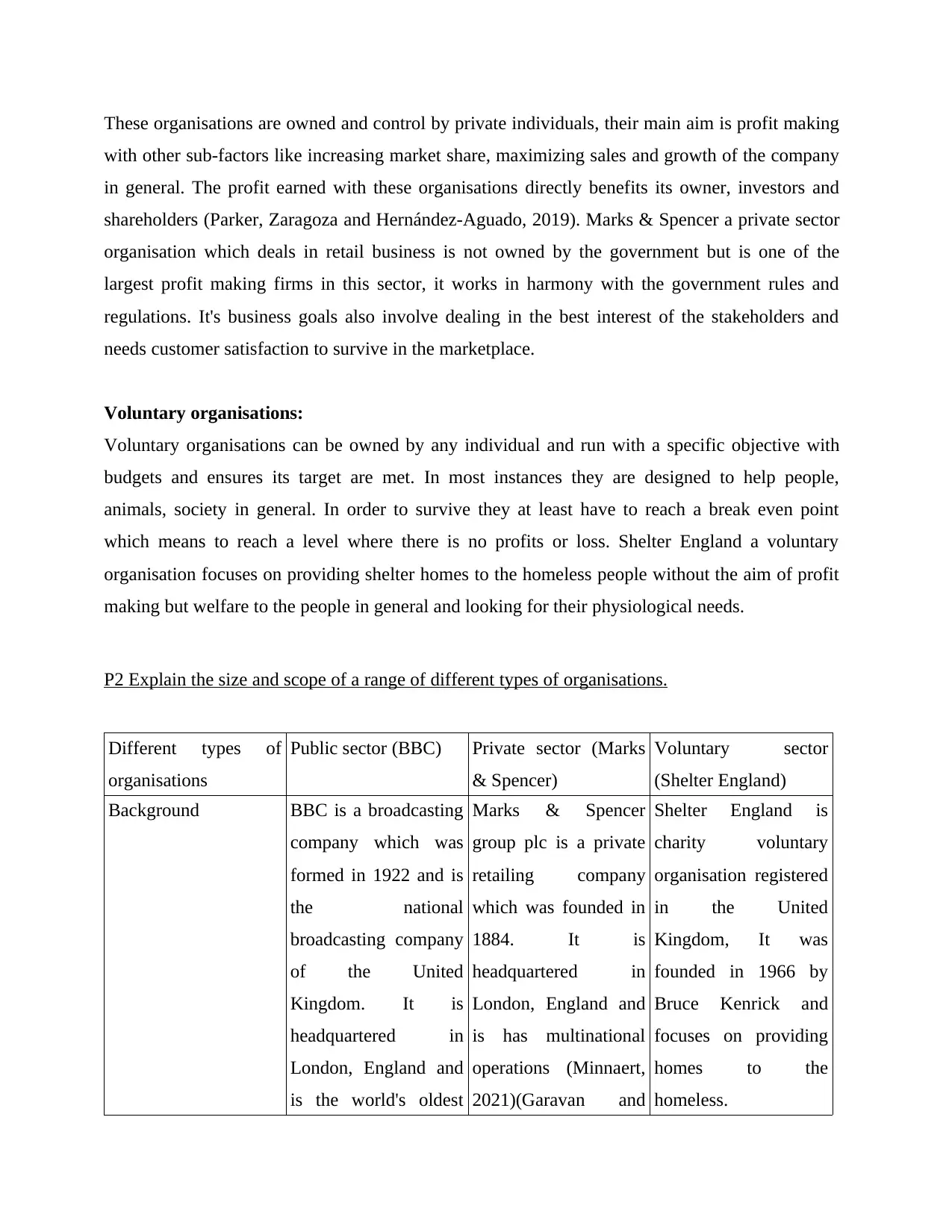
These organisations are owned and control by private individuals, their main aim is profit making
with other sub-factors like increasing market share, maximizing sales and growth of the company
in general. The profit earned with these organisations directly benefits its owner, investors and
shareholders (Parker, Zaragoza and Hernández-Aguado, 2019). Marks & Spencer a private sector
organisation which deals in retail business is not owned by the government but is one of the
largest profit making firms in this sector, it works in harmony with the government rules and
regulations. It's business goals also involve dealing in the best interest of the stakeholders and
needs customer satisfaction to survive in the marketplace.
Voluntary organisations:
Voluntary organisations can be owned by any individual and run with a specific objective with
budgets and ensures its target are met. In most instances they are designed to help people,
animals, society in general. In order to survive they at least have to reach a break even point
which means to reach a level where there is no profits or loss. Shelter England a voluntary
organisation focuses on providing shelter homes to the homeless people without the aim of profit
making but welfare to the people in general and looking for their physiological needs.
P2 Explain the size and scope of a range of different types of organisations.
Different types of
organisations
Public sector (BBC) Private sector (Marks
& Spencer)
Voluntary sector
(Shelter England)
Background BBC is a broadcasting
company which was
formed in 1922 and is
the national
broadcasting company
of the United
Kingdom. It is
headquartered in
London, England and
is the world's oldest
Marks & Spencer
group plc is a private
retailing company
which was founded in
1884. It is
headquartered in
London, England and
is has multinational
operations (Minnaert,
2021)(Garavan and
Shelter England is
charity voluntary
organisation registered
in the United
Kingdom, It was
founded in 1966 by
Bruce Kenrick and
focuses on providing
homes to the
homeless.
with other sub-factors like increasing market share, maximizing sales and growth of the company
in general. The profit earned with these organisations directly benefits its owner, investors and
shareholders (Parker, Zaragoza and Hernández-Aguado, 2019). Marks & Spencer a private sector
organisation which deals in retail business is not owned by the government but is one of the
largest profit making firms in this sector, it works in harmony with the government rules and
regulations. It's business goals also involve dealing in the best interest of the stakeholders and
needs customer satisfaction to survive in the marketplace.
Voluntary organisations:
Voluntary organisations can be owned by any individual and run with a specific objective with
budgets and ensures its target are met. In most instances they are designed to help people,
animals, society in general. In order to survive they at least have to reach a break even point
which means to reach a level where there is no profits or loss. Shelter England a voluntary
organisation focuses on providing shelter homes to the homeless people without the aim of profit
making but welfare to the people in general and looking for their physiological needs.
P2 Explain the size and scope of a range of different types of organisations.
Different types of
organisations
Public sector (BBC) Private sector (Marks
& Spencer)
Voluntary sector
(Shelter England)
Background BBC is a broadcasting
company which was
formed in 1922 and is
the national
broadcasting company
of the United
Kingdom. It is
headquartered in
London, England and
is the world's oldest
Marks & Spencer
group plc is a private
retailing company
which was founded in
1884. It is
headquartered in
London, England and
is has multinational
operations (Minnaert,
2021)(Garavan and
Shelter England is
charity voluntary
organisation registered
in the United
Kingdom, It was
founded in 1966 by
Bruce Kenrick and
focuses on providing
homes to the
homeless.
Paraphrase This Document
Need a fresh take? Get an instant paraphrase of this document with our AI Paraphraser

national broadcaster. et.al., 2021)
Products & services News broadcasting,
sports broadcasting,
weather broadcasting,
BBC sounds, BBC red
button and more.
Upmarket T-shirts,
cheap and good value
utilitarian umbrellas,
girls good value jeans,
girls shoes and more.
Provides legal
services, free support
for people who have
lost their homes or are
facing eviction,
housing to homeless
people.
Size & scope BBC employees a total
of 22,000 employees
out of which approx.
19000 are currently
employed in the public
sector broadcasting.
BBC has been
established under a
charter which is royal
and operates under the
agreement with the
state of digital, media,
sport and culture.
Marks & Spencer
which use to employee
a total of 85,209
employees in 2017
currently employees
only 66,210
employees which is
still a big number but
it has decreased a lot
in the recent years.
Shelter employees a
total of 1412
employees who focus
on consumer services,
foundations, charitable
organisations, housing
advice, advocacy,
training and research.
Vision and mission BBC has a vision to
serve in public interest
and also to serve the
audiences with high
quality, distinctive and
impartial output and
services that educate,
inform and entertain
them. Its mission is to
meet the needs of
Marks & Spencer
visions to provide
standard against its
competitors and
quantify everything
easily. Its mission is to
provide quality
products like foods,
apparel, home
products and more. It
Shelter England has a
vision to cooperate
with the government to
meet the target of
300,000 homes each
year. It also missions
to provide affordable
social homes in large
number of 3.1 million
over the course of 20
Products & services News broadcasting,
sports broadcasting,
weather broadcasting,
BBC sounds, BBC red
button and more.
Upmarket T-shirts,
cheap and good value
utilitarian umbrellas,
girls good value jeans,
girls shoes and more.
Provides legal
services, free support
for people who have
lost their homes or are
facing eviction,
housing to homeless
people.
Size & scope BBC employees a total
of 22,000 employees
out of which approx.
19000 are currently
employed in the public
sector broadcasting.
BBC has been
established under a
charter which is royal
and operates under the
agreement with the
state of digital, media,
sport and culture.
Marks & Spencer
which use to employee
a total of 85,209
employees in 2017
currently employees
only 66,210
employees which is
still a big number but
it has decreased a lot
in the recent years.
Shelter employees a
total of 1412
employees who focus
on consumer services,
foundations, charitable
organisations, housing
advice, advocacy,
training and research.
Vision and mission BBC has a vision to
serve in public interest
and also to serve the
audiences with high
quality, distinctive and
impartial output and
services that educate,
inform and entertain
them. Its mission is to
meet the needs of
Marks & Spencer
visions to provide
standard against its
competitors and
quantify everything
easily. Its mission is to
provide quality
products like foods,
apparel, home
products and more. It
Shelter England has a
vision to cooperate
with the government to
meet the target of
300,000 homes each
year. It also missions
to provide affordable
social homes in large
number of 3.1 million
over the course of 20
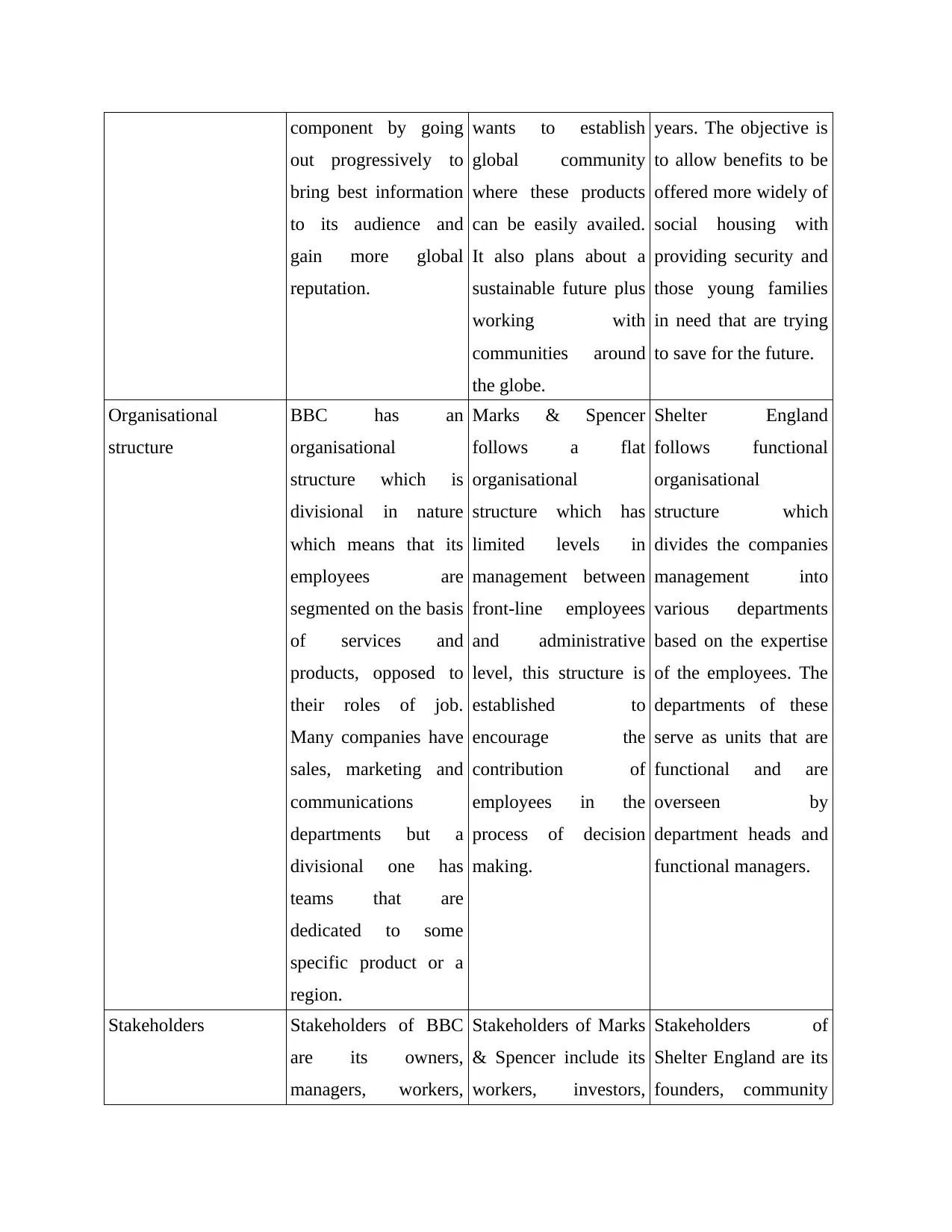
component by going
out progressively to
bring best information
to its audience and
gain more global
reputation.
wants to establish
global community
where these products
can be easily availed.
It also plans about a
sustainable future plus
working with
communities around
the globe.
years. The objective is
to allow benefits to be
offered more widely of
social housing with
providing security and
those young families
in need that are trying
to save for the future.
Organisational
structure
BBC has an
organisational
structure which is
divisional in nature
which means that its
employees are
segmented on the basis
of services and
products, opposed to
their roles of job.
Many companies have
sales, marketing and
communications
departments but a
divisional one has
teams that are
dedicated to some
specific product or a
region.
Marks & Spencer
follows a flat
organisational
structure which has
limited levels in
management between
front-line employees
and administrative
level, this structure is
established to
encourage the
contribution of
employees in the
process of decision
making.
Shelter England
follows functional
organisational
structure which
divides the companies
management into
various departments
based on the expertise
of the employees. The
departments of these
serve as units that are
functional and are
overseen by
department heads and
functional managers.
Stakeholders Stakeholders of BBC
are its owners,
managers, workers,
Stakeholders of Marks
& Spencer include its
workers, investors,
Stakeholders of
Shelter England are its
founders, community
out progressively to
bring best information
to its audience and
gain more global
reputation.
wants to establish
global community
where these products
can be easily availed.
It also plans about a
sustainable future plus
working with
communities around
the globe.
years. The objective is
to allow benefits to be
offered more widely of
social housing with
providing security and
those young families
in need that are trying
to save for the future.
Organisational
structure
BBC has an
organisational
structure which is
divisional in nature
which means that its
employees are
segmented on the basis
of services and
products, opposed to
their roles of job.
Many companies have
sales, marketing and
communications
departments but a
divisional one has
teams that are
dedicated to some
specific product or a
region.
Marks & Spencer
follows a flat
organisational
structure which has
limited levels in
management between
front-line employees
and administrative
level, this structure is
established to
encourage the
contribution of
employees in the
process of decision
making.
Shelter England
follows functional
organisational
structure which
divides the companies
management into
various departments
based on the expertise
of the employees. The
departments of these
serve as units that are
functional and are
overseen by
department heads and
functional managers.
Stakeholders Stakeholders of BBC
are its owners,
managers, workers,
Stakeholders of Marks
& Spencer include its
workers, investors,
Stakeholders of
Shelter England are its
founders, community
⊘ This is a preview!⊘
Do you want full access?
Subscribe today to unlock all pages.

Trusted by 1+ million students worldwide
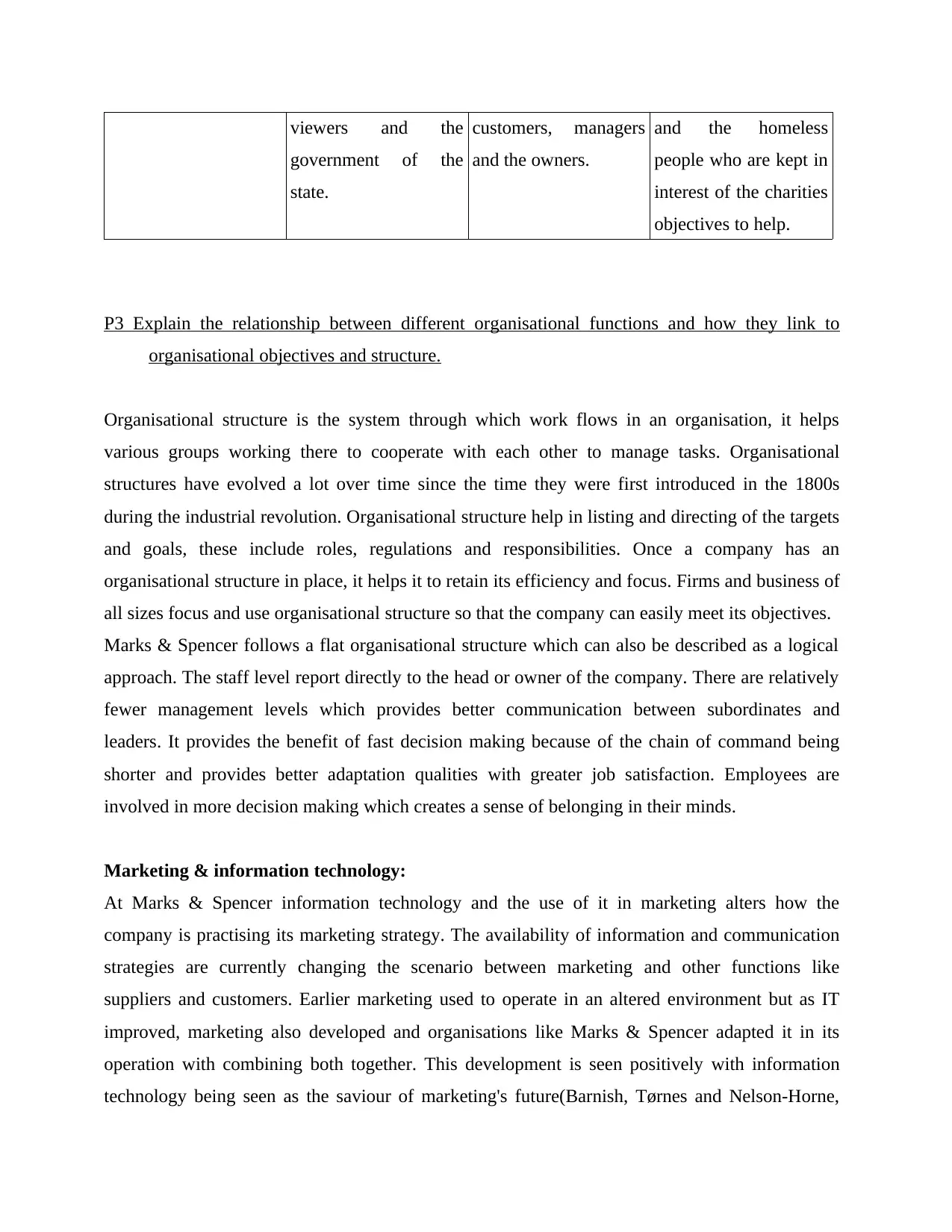
viewers and the
government of the
state.
customers, managers
and the owners.
and the homeless
people who are kept in
interest of the charities
objectives to help.
P3 Explain the relationship between different organisational functions and how they link to
organisational objectives and structure.
Organisational structure is the system through which work flows in an organisation, it helps
various groups working there to cooperate with each other to manage tasks. Organisational
structures have evolved a lot over time since the time they were first introduced in the 1800s
during the industrial revolution. Organisational structure help in listing and directing of the targets
and goals, these include roles, regulations and responsibilities. Once a company has an
organisational structure in place, it helps it to retain its efficiency and focus. Firms and business of
all sizes focus and use organisational structure so that the company can easily meet its objectives.
Marks & Spencer follows a flat organisational structure which can also be described as a logical
approach. The staff level report directly to the head or owner of the company. There are relatively
fewer management levels which provides better communication between subordinates and
leaders. It provides the benefit of fast decision making because of the chain of command being
shorter and provides better adaptation qualities with greater job satisfaction. Employees are
involved in more decision making which creates a sense of belonging in their minds.
Marketing & information technology:
At Marks & Spencer information technology and the use of it in marketing alters how the
company is practising its marketing strategy. The availability of information and communication
strategies are currently changing the scenario between marketing and other functions like
suppliers and customers. Earlier marketing used to operate in an altered environment but as IT
improved, marketing also developed and organisations like Marks & Spencer adapted it in its
operation with combining both together. This development is seen positively with information
technology being seen as the saviour of marketing's future(Barnish, Tørnes and Nelson-Horne,
government of the
state.
customers, managers
and the owners.
and the homeless
people who are kept in
interest of the charities
objectives to help.
P3 Explain the relationship between different organisational functions and how they link to
organisational objectives and structure.
Organisational structure is the system through which work flows in an organisation, it helps
various groups working there to cooperate with each other to manage tasks. Organisational
structures have evolved a lot over time since the time they were first introduced in the 1800s
during the industrial revolution. Organisational structure help in listing and directing of the targets
and goals, these include roles, regulations and responsibilities. Once a company has an
organisational structure in place, it helps it to retain its efficiency and focus. Firms and business of
all sizes focus and use organisational structure so that the company can easily meet its objectives.
Marks & Spencer follows a flat organisational structure which can also be described as a logical
approach. The staff level report directly to the head or owner of the company. There are relatively
fewer management levels which provides better communication between subordinates and
leaders. It provides the benefit of fast decision making because of the chain of command being
shorter and provides better adaptation qualities with greater job satisfaction. Employees are
involved in more decision making which creates a sense of belonging in their minds.
Marketing & information technology:
At Marks & Spencer information technology and the use of it in marketing alters how the
company is practising its marketing strategy. The availability of information and communication
strategies are currently changing the scenario between marketing and other functions like
suppliers and customers. Earlier marketing used to operate in an altered environment but as IT
improved, marketing also developed and organisations like Marks & Spencer adapted it in its
operation with combining both together. This development is seen positively with information
technology being seen as the saviour of marketing's future(Barnish, Tørnes and Nelson-Horne,
Paraphrase This Document
Need a fresh take? Get an instant paraphrase of this document with our AI Paraphraser
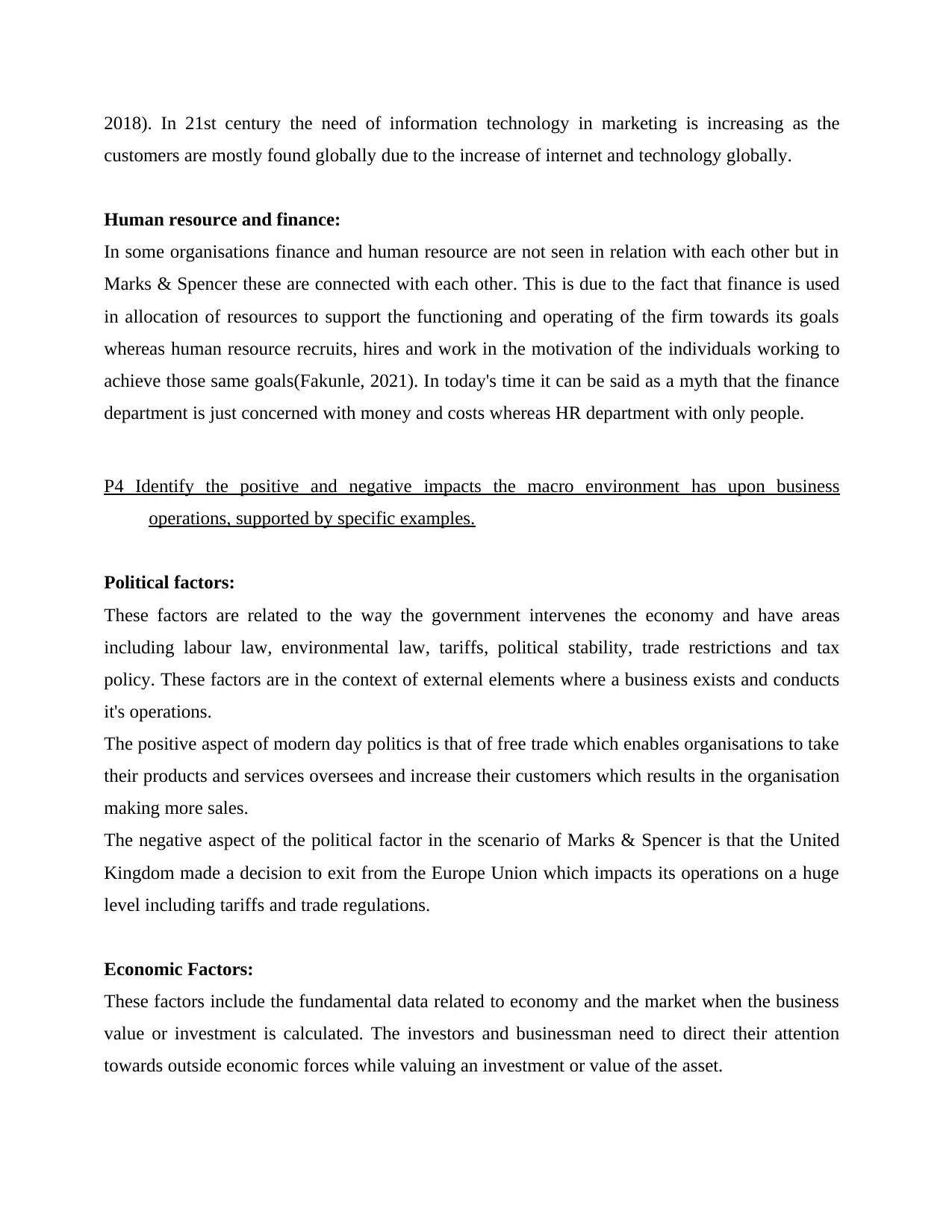
2018). In 21st century the need of information technology in marketing is increasing as the
customers are mostly found globally due to the increase of internet and technology globally.
Human resource and finance:
In some organisations finance and human resource are not seen in relation with each other but in
Marks & Spencer these are connected with each other. This is due to the fact that finance is used
in allocation of resources to support the functioning and operating of the firm towards its goals
whereas human resource recruits, hires and work in the motivation of the individuals working to
achieve those same goals(Fakunle, 2021). In today's time it can be said as a myth that the finance
department is just concerned with money and costs whereas HR department with only people.
P4 Identify the positive and negative impacts the macro environment has upon business
operations, supported by specific examples.
Political factors:
These factors are related to the way the government intervenes the economy and have areas
including labour law, environmental law, tariffs, political stability, trade restrictions and tax
policy. These factors are in the context of external elements where a business exists and conducts
it's operations.
The positive aspect of modern day politics is that of free trade which enables organisations to take
their products and services oversees and increase their customers which results in the organisation
making more sales.
The negative aspect of the political factor in the scenario of Marks & Spencer is that the United
Kingdom made a decision to exit from the Europe Union which impacts its operations on a huge
level including tariffs and trade regulations.
Economic Factors:
These factors include the fundamental data related to economy and the market when the business
value or investment is calculated. The investors and businessman need to direct their attention
towards outside economic forces while valuing an investment or value of the asset.
customers are mostly found globally due to the increase of internet and technology globally.
Human resource and finance:
In some organisations finance and human resource are not seen in relation with each other but in
Marks & Spencer these are connected with each other. This is due to the fact that finance is used
in allocation of resources to support the functioning and operating of the firm towards its goals
whereas human resource recruits, hires and work in the motivation of the individuals working to
achieve those same goals(Fakunle, 2021). In today's time it can be said as a myth that the finance
department is just concerned with money and costs whereas HR department with only people.
P4 Identify the positive and negative impacts the macro environment has upon business
operations, supported by specific examples.
Political factors:
These factors are related to the way the government intervenes the economy and have areas
including labour law, environmental law, tariffs, political stability, trade restrictions and tax
policy. These factors are in the context of external elements where a business exists and conducts
it's operations.
The positive aspect of modern day politics is that of free trade which enables organisations to take
their products and services oversees and increase their customers which results in the organisation
making more sales.
The negative aspect of the political factor in the scenario of Marks & Spencer is that the United
Kingdom made a decision to exit from the Europe Union which impacts its operations on a huge
level including tariffs and trade regulations.
Economic Factors:
These factors include the fundamental data related to economy and the market when the business
value or investment is calculated. The investors and businessman need to direct their attention
towards outside economic forces while valuing an investment or value of the asset.
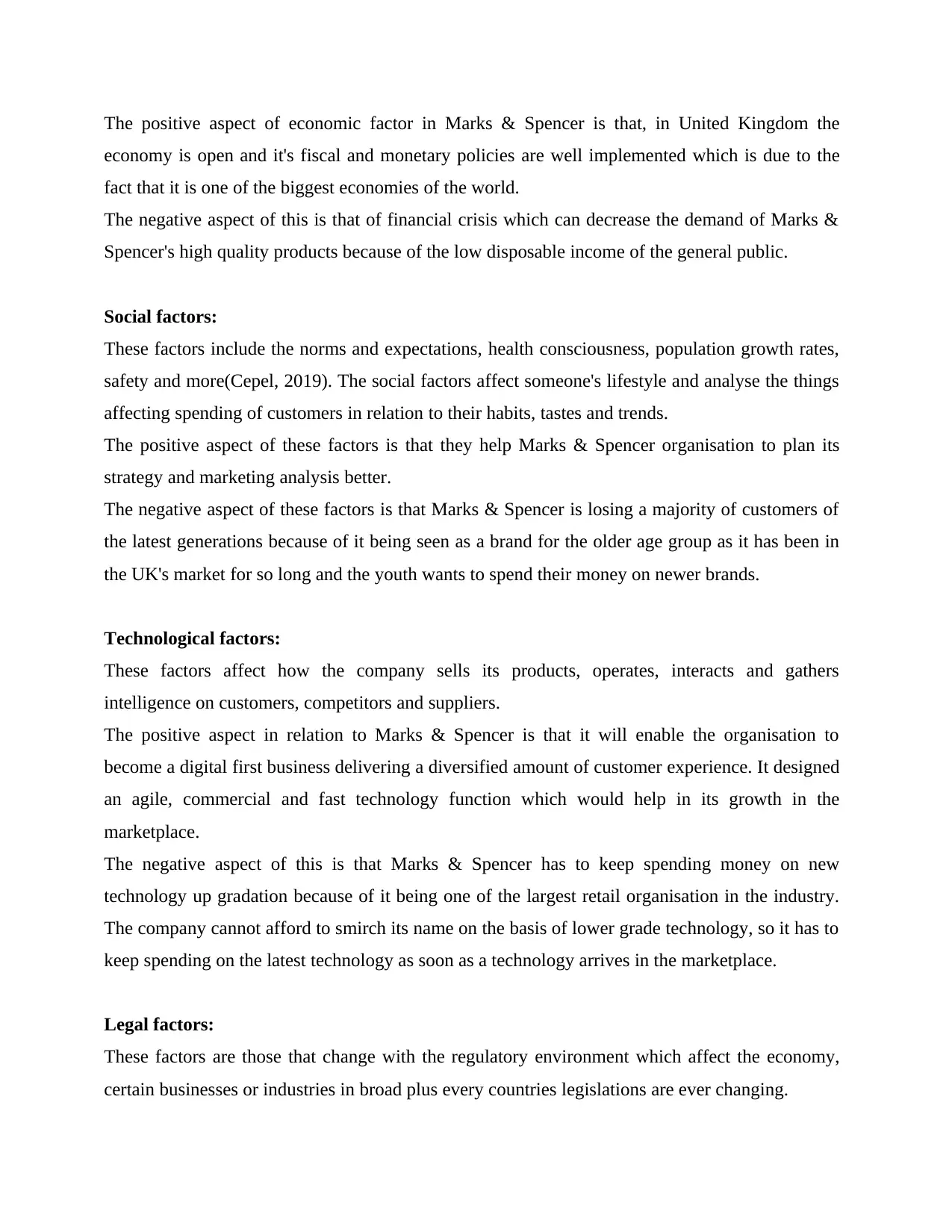
The positive aspect of economic factor in Marks & Spencer is that, in United Kingdom the
economy is open and it's fiscal and monetary policies are well implemented which is due to the
fact that it is one of the biggest economies of the world.
The negative aspect of this is that of financial crisis which can decrease the demand of Marks &
Spencer's high quality products because of the low disposable income of the general public.
Social factors:
These factors include the norms and expectations, health consciousness, population growth rates,
safety and more(Cepel, 2019). The social factors affect someone's lifestyle and analyse the things
affecting spending of customers in relation to their habits, tastes and trends.
The positive aspect of these factors is that they help Marks & Spencer organisation to plan its
strategy and marketing analysis better.
The negative aspect of these factors is that Marks & Spencer is losing a majority of customers of
the latest generations because of it being seen as a brand for the older age group as it has been in
the UK's market for so long and the youth wants to spend their money on newer brands.
Technological factors:
These factors affect how the company sells its products, operates, interacts and gathers
intelligence on customers, competitors and suppliers.
The positive aspect in relation to Marks & Spencer is that it will enable the organisation to
become a digital first business delivering a diversified amount of customer experience. It designed
an agile, commercial and fast technology function which would help in its growth in the
marketplace.
The negative aspect of this is that Marks & Spencer has to keep spending money on new
technology up gradation because of it being one of the largest retail organisation in the industry.
The company cannot afford to smirch its name on the basis of lower grade technology, so it has to
keep spending on the latest technology as soon as a technology arrives in the marketplace.
Legal factors:
These factors are those that change with the regulatory environment which affect the economy,
certain businesses or industries in broad plus every countries legislations are ever changing.
economy is open and it's fiscal and monetary policies are well implemented which is due to the
fact that it is one of the biggest economies of the world.
The negative aspect of this is that of financial crisis which can decrease the demand of Marks &
Spencer's high quality products because of the low disposable income of the general public.
Social factors:
These factors include the norms and expectations, health consciousness, population growth rates,
safety and more(Cepel, 2019). The social factors affect someone's lifestyle and analyse the things
affecting spending of customers in relation to their habits, tastes and trends.
The positive aspect of these factors is that they help Marks & Spencer organisation to plan its
strategy and marketing analysis better.
The negative aspect of these factors is that Marks & Spencer is losing a majority of customers of
the latest generations because of it being seen as a brand for the older age group as it has been in
the UK's market for so long and the youth wants to spend their money on newer brands.
Technological factors:
These factors affect how the company sells its products, operates, interacts and gathers
intelligence on customers, competitors and suppliers.
The positive aspect in relation to Marks & Spencer is that it will enable the organisation to
become a digital first business delivering a diversified amount of customer experience. It designed
an agile, commercial and fast technology function which would help in its growth in the
marketplace.
The negative aspect of this is that Marks & Spencer has to keep spending money on new
technology up gradation because of it being one of the largest retail organisation in the industry.
The company cannot afford to smirch its name on the basis of lower grade technology, so it has to
keep spending on the latest technology as soon as a technology arrives in the marketplace.
Legal factors:
These factors are those that change with the regulatory environment which affect the economy,
certain businesses or industries in broad plus every countries legislations are ever changing.
⊘ This is a preview!⊘
Do you want full access?
Subscribe today to unlock all pages.

Trusted by 1+ million students worldwide
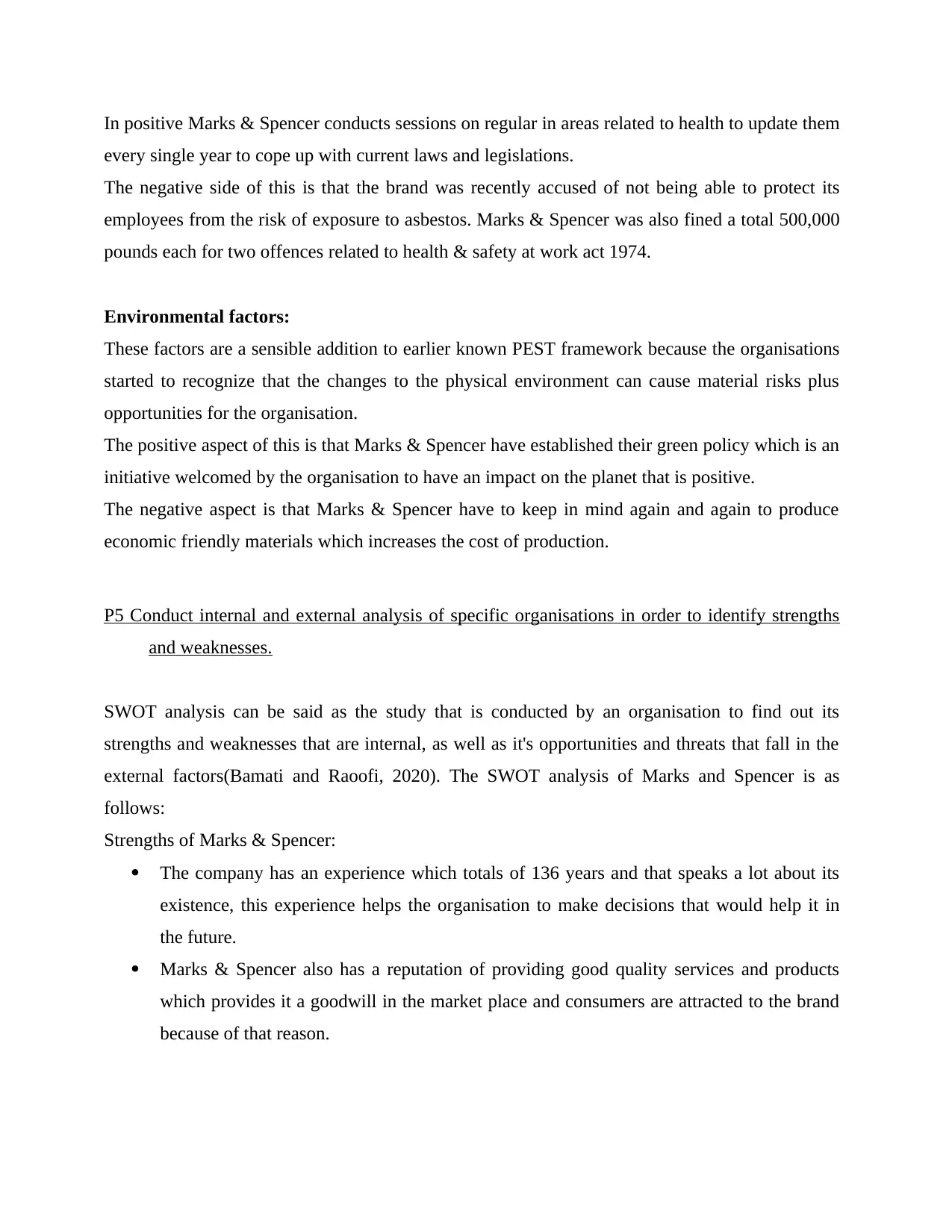
In positive Marks & Spencer conducts sessions on regular in areas related to health to update them
every single year to cope up with current laws and legislations.
The negative side of this is that the brand was recently accused of not being able to protect its
employees from the risk of exposure to asbestos. Marks & Spencer was also fined a total 500,000
pounds each for two offences related to health & safety at work act 1974.
Environmental factors:
These factors are a sensible addition to earlier known PEST framework because the organisations
started to recognize that the changes to the physical environment can cause material risks plus
opportunities for the organisation.
The positive aspect of this is that Marks & Spencer have established their green policy which is an
initiative welcomed by the organisation to have an impact on the planet that is positive.
The negative aspect is that Marks & Spencer have to keep in mind again and again to produce
economic friendly materials which increases the cost of production.
P5 Conduct internal and external analysis of specific organisations in order to identify strengths
and weaknesses.
SWOT analysis can be said as the study that is conducted by an organisation to find out its
strengths and weaknesses that are internal, as well as it's opportunities and threats that fall in the
external factors(Bamati and Raoofi, 2020). The SWOT analysis of Marks and Spencer is as
follows:
Strengths of Marks & Spencer:
The company has an experience which totals of 136 years and that speaks a lot about its
existence, this experience helps the organisation to make decisions that would help it in
the future.
Marks & Spencer also has a reputation of providing good quality services and products
which provides it a goodwill in the market place and consumers are attracted to the brand
because of that reason.
every single year to cope up with current laws and legislations.
The negative side of this is that the brand was recently accused of not being able to protect its
employees from the risk of exposure to asbestos. Marks & Spencer was also fined a total 500,000
pounds each for two offences related to health & safety at work act 1974.
Environmental factors:
These factors are a sensible addition to earlier known PEST framework because the organisations
started to recognize that the changes to the physical environment can cause material risks plus
opportunities for the organisation.
The positive aspect of this is that Marks & Spencer have established their green policy which is an
initiative welcomed by the organisation to have an impact on the planet that is positive.
The negative aspect is that Marks & Spencer have to keep in mind again and again to produce
economic friendly materials which increases the cost of production.
P5 Conduct internal and external analysis of specific organisations in order to identify strengths
and weaknesses.
SWOT analysis can be said as the study that is conducted by an organisation to find out its
strengths and weaknesses that are internal, as well as it's opportunities and threats that fall in the
external factors(Bamati and Raoofi, 2020). The SWOT analysis of Marks and Spencer is as
follows:
Strengths of Marks & Spencer:
The company has an experience which totals of 136 years and that speaks a lot about its
existence, this experience helps the organisation to make decisions that would help it in
the future.
Marks & Spencer also has a reputation of providing good quality services and products
which provides it a goodwill in the market place and consumers are attracted to the brand
because of that reason.
Paraphrase This Document
Need a fresh take? Get an instant paraphrase of this document with our AI Paraphraser
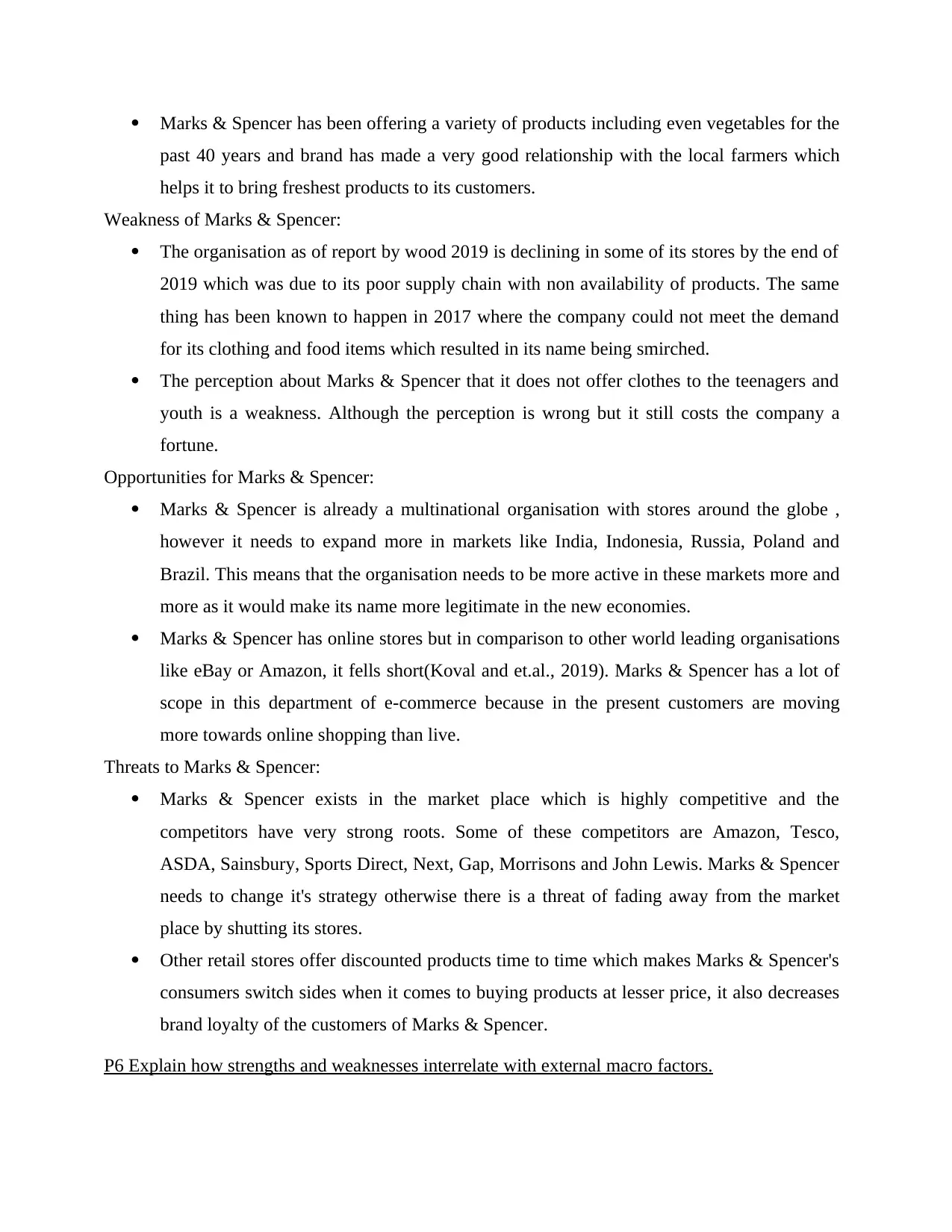
Marks & Spencer has been offering a variety of products including even vegetables for the
past 40 years and brand has made a very good relationship with the local farmers which
helps it to bring freshest products to its customers.
Weakness of Marks & Spencer:
The organisation as of report by wood 2019 is declining in some of its stores by the end of
2019 which was due to its poor supply chain with non availability of products. The same
thing has been known to happen in 2017 where the company could not meet the demand
for its clothing and food items which resulted in its name being smirched.
The perception about Marks & Spencer that it does not offer clothes to the teenagers and
youth is a weakness. Although the perception is wrong but it still costs the company a
fortune.
Opportunities for Marks & Spencer:
Marks & Spencer is already a multinational organisation with stores around the globe ,
however it needs to expand more in markets like India, Indonesia, Russia, Poland and
Brazil. This means that the organisation needs to be more active in these markets more and
more as it would make its name more legitimate in the new economies.
Marks & Spencer has online stores but in comparison to other world leading organisations
like eBay or Amazon, it fells short(Koval and et.al., 2019). Marks & Spencer has a lot of
scope in this department of e-commerce because in the present customers are moving
more towards online shopping than live.
Threats to Marks & Spencer:
Marks & Spencer exists in the market place which is highly competitive and the
competitors have very strong roots. Some of these competitors are Amazon, Tesco,
ASDA, Sainsbury, Sports Direct, Next, Gap, Morrisons and John Lewis. Marks & Spencer
needs to change it's strategy otherwise there is a threat of fading away from the market
place by shutting its stores.
Other retail stores offer discounted products time to time which makes Marks & Spencer's
consumers switch sides when it comes to buying products at lesser price, it also decreases
brand loyalty of the customers of Marks & Spencer.
P6 Explain how strengths and weaknesses interrelate with external macro factors.
past 40 years and brand has made a very good relationship with the local farmers which
helps it to bring freshest products to its customers.
Weakness of Marks & Spencer:
The organisation as of report by wood 2019 is declining in some of its stores by the end of
2019 which was due to its poor supply chain with non availability of products. The same
thing has been known to happen in 2017 where the company could not meet the demand
for its clothing and food items which resulted in its name being smirched.
The perception about Marks & Spencer that it does not offer clothes to the teenagers and
youth is a weakness. Although the perception is wrong but it still costs the company a
fortune.
Opportunities for Marks & Spencer:
Marks & Spencer is already a multinational organisation with stores around the globe ,
however it needs to expand more in markets like India, Indonesia, Russia, Poland and
Brazil. This means that the organisation needs to be more active in these markets more and
more as it would make its name more legitimate in the new economies.
Marks & Spencer has online stores but in comparison to other world leading organisations
like eBay or Amazon, it fells short(Koval and et.al., 2019). Marks & Spencer has a lot of
scope in this department of e-commerce because in the present customers are moving
more towards online shopping than live.
Threats to Marks & Spencer:
Marks & Spencer exists in the market place which is highly competitive and the
competitors have very strong roots. Some of these competitors are Amazon, Tesco,
ASDA, Sainsbury, Sports Direct, Next, Gap, Morrisons and John Lewis. Marks & Spencer
needs to change it's strategy otherwise there is a threat of fading away from the market
place by shutting its stores.
Other retail stores offer discounted products time to time which makes Marks & Spencer's
consumers switch sides when it comes to buying products at lesser price, it also decreases
brand loyalty of the customers of Marks & Spencer.
P6 Explain how strengths and weaknesses interrelate with external macro factors.
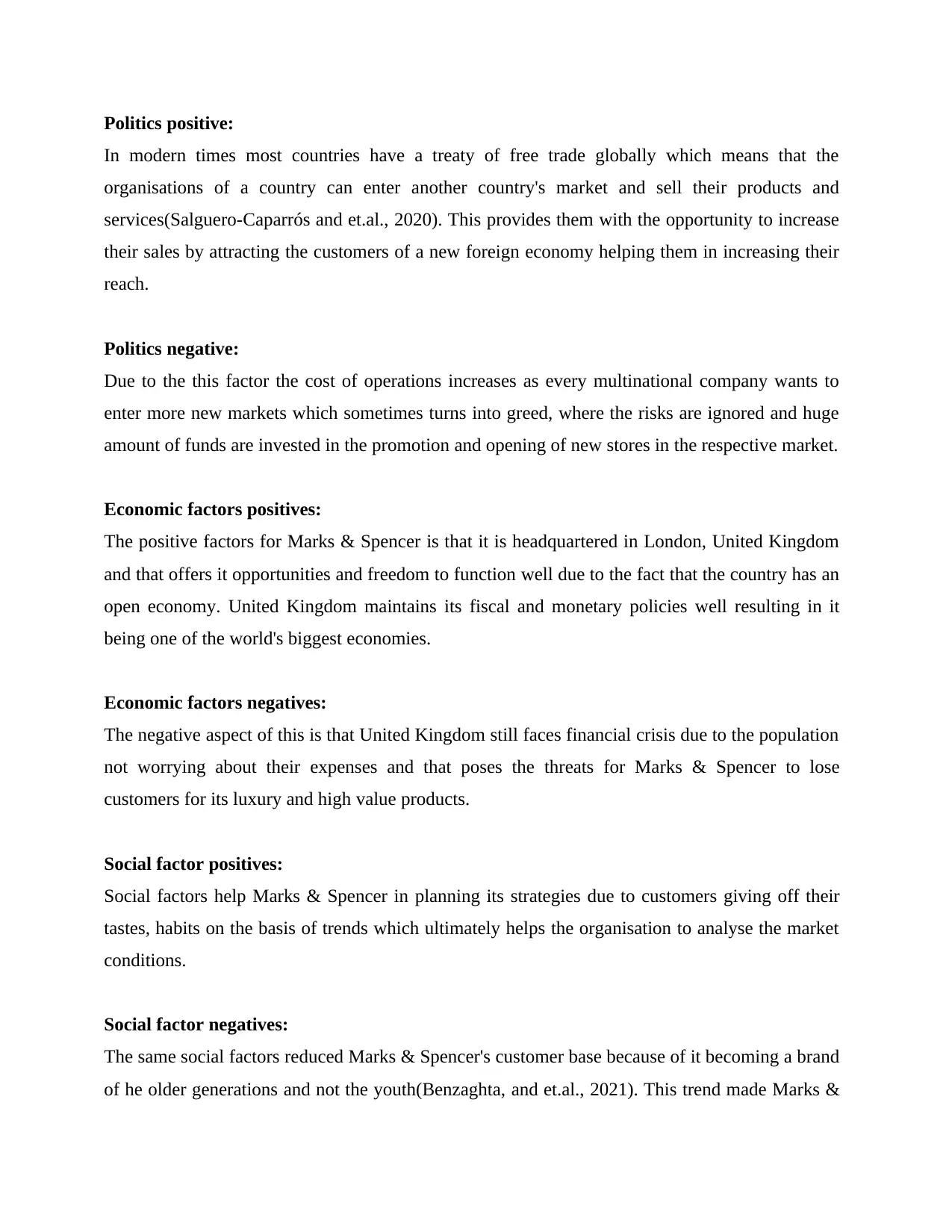
Politics positive:
In modern times most countries have a treaty of free trade globally which means that the
organisations of a country can enter another country's market and sell their products and
services(Salguero-Caparrós and et.al., 2020). This provides them with the opportunity to increase
their sales by attracting the customers of a new foreign economy helping them in increasing their
reach.
Politics negative:
Due to the this factor the cost of operations increases as every multinational company wants to
enter more new markets which sometimes turns into greed, where the risks are ignored and huge
amount of funds are invested in the promotion and opening of new stores in the respective market.
Economic factors positives:
The positive factors for Marks & Spencer is that it is headquartered in London, United Kingdom
and that offers it opportunities and freedom to function well due to the fact that the country has an
open economy. United Kingdom maintains its fiscal and monetary policies well resulting in it
being one of the world's biggest economies.
Economic factors negatives:
The negative aspect of this is that United Kingdom still faces financial crisis due to the population
not worrying about their expenses and that poses the threats for Marks & Spencer to lose
customers for its luxury and high value products.
Social factor positives:
Social factors help Marks & Spencer in planning its strategies due to customers giving off their
tastes, habits on the basis of trends which ultimately helps the organisation to analyse the market
conditions.
Social factor negatives:
The same social factors reduced Marks & Spencer's customer base because of it becoming a brand
of he older generations and not the youth(Benzaghta, and et.al., 2021). This trend made Marks &
In modern times most countries have a treaty of free trade globally which means that the
organisations of a country can enter another country's market and sell their products and
services(Salguero-Caparrós and et.al., 2020). This provides them with the opportunity to increase
their sales by attracting the customers of a new foreign economy helping them in increasing their
reach.
Politics negative:
Due to the this factor the cost of operations increases as every multinational company wants to
enter more new markets which sometimes turns into greed, where the risks are ignored and huge
amount of funds are invested in the promotion and opening of new stores in the respective market.
Economic factors positives:
The positive factors for Marks & Spencer is that it is headquartered in London, United Kingdom
and that offers it opportunities and freedom to function well due to the fact that the country has an
open economy. United Kingdom maintains its fiscal and monetary policies well resulting in it
being one of the world's biggest economies.
Economic factors negatives:
The negative aspect of this is that United Kingdom still faces financial crisis due to the population
not worrying about their expenses and that poses the threats for Marks & Spencer to lose
customers for its luxury and high value products.
Social factor positives:
Social factors help Marks & Spencer in planning its strategies due to customers giving off their
tastes, habits on the basis of trends which ultimately helps the organisation to analyse the market
conditions.
Social factor negatives:
The same social factors reduced Marks & Spencer's customer base because of it becoming a brand
of he older generations and not the youth(Benzaghta, and et.al., 2021). This trend made Marks &
⊘ This is a preview!⊘
Do you want full access?
Subscribe today to unlock all pages.

Trusted by 1+ million students worldwide
1 out of 17
Related Documents
Your All-in-One AI-Powered Toolkit for Academic Success.
+13062052269
info@desklib.com
Available 24*7 on WhatsApp / Email
![[object Object]](/_next/static/media/star-bottom.7253800d.svg)
Unlock your academic potential
Copyright © 2020–2025 A2Z Services. All Rights Reserved. Developed and managed by ZUCOL.




